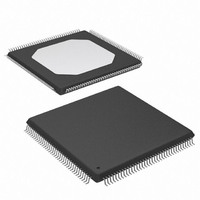XC3S250E-4TQG144C Xilinx Inc, XC3S250E-4TQG144C Datasheet - Page 57

XC3S250E-4TQG144C
Manufacturer Part Number
XC3S250E-4TQG144C
Description
IC SPARTAN-3E FPGA 250K 144TQFP
Manufacturer
Xilinx Inc
Series
Spartan™-3Er
Datasheet
1.XC3S100E-4VQG100C.pdf
(233 pages)
Specifications of XC3S250E-4TQG144C
Number Of Logic Elements/cells
5508
Number Of Labs/clbs
612
Total Ram Bits
221184
Number Of I /o
108
Number Of Gates
250000
Voltage - Supply
1.14 V ~ 1.26 V
Mounting Type
Surface Mount
Operating Temperature
0°C ~ 85°C
Package / Case
144-LQFP
For Use With
813-1009 - MODULE USB-TO-FPGA TOOL W/MANUAL
Lead Free Status / RoHS Status
Lead free / RoHS Compliant
Other names
122-1524
Available stocks
Company
Part Number
Manufacturer
Quantity
Price
Company:
Part Number:
XC3S250E-4TQG144C
Manufacturer:
XILINX
Quantity:
2 000
Company:
Part Number:
XC3S250E-4TQG144C
Manufacturer:
XILINX
Quantity:
2 400
Company:
Part Number:
XC3S250E-4TQG144C
Manufacturer:
Xilinx Inc
Quantity:
10 000
Part Number:
XC3S250E-4TQG144C
Manufacturer:
XILINX/赛灵思
Quantity:
20 000
Part Number:
XC3S250E-4TQG144CS1
Manufacturer:
XILINX/赛灵思
Quantity:
20 000
VARIABLE Phase Shift Mode
In VARIABLE phase shift mode, the FPGA application
dynamically adjusts the fine phase shift value using three
Table 36: Signals for Variable Phase Mode
The FPGA application uses the three PS inputs on the
Phase Shift unit to dynamically and incrementally increase
or decrease the phase shift amount on all nine DCM clock
outputs.
To adjust the current phase shift value, the PSEN enable
signal must be High to enable the PS unit. Coincidently,
PSINCDEC must be High to increment the current phase
shift amount or Low to decrement the current amount. All
VARIABLE phase shift operations are controlled by the
PSCLK input, which can be the CLKIN signal or any other
clock signal.
Design Note
The VARIABLE phase shift feature operates differently from
the Spartan-3 DCM but the DCM design primitive is com-
mon to both Spartan-3 and Spartan-3E design entry. Vari-
able phase shift in Spartan-3E FPGAs behaves as
described herein. However, the DCM design primitive and
simulation model does not match this behavior. Starting
with ISE 8.1i, Service Pack 3, using the VARIABLE attribute
generates an error message. The following Answer Record
describes how to re-enable the VARIABLE phase shift fea-
ture.
http://www.xilinx.com/support/answers/23004.htm
DCM_DELAY_STEP
DCM_DELAY_STEP is the finest delay resolution available
in the PS unit. Its value is provided at the bottom of
Table 105
PSINCDEC is High, the PS unit adds one DCM_
DELAY_STEP of phase shift to all nine DCM outputs. Simi-
larly, for each enabled PSCLK cycle that PSINCDEC is Low,
DS312-2 (v3.8) August 26, 2009
Product Specification
Notes:
1.
PSEN
PSCLK
PSINCDEC
PSDONE
This input supports either a true or inverted polarity.
Signal
(1)
(1)
in Module 3. For each enabled PSCLK cycle that
R
(1)
Input
Input
Input
Output
Direction
Enables the Phase Shift unit for variable phase adjustment.
Clock to synchronize phase shift adjustment.
When High, increments the current phase shift value. When Low, decrements the
current phase shift value. This signal is synchronized to the PSCLK signal.
Goes High to indicate that the present phase adjustment is complete and PS unit is
ready for next phase adjustment request. This signal is synchronized to the PSCLK
signal.
www.xilinx.com
inputs to the PS unit (PSEN, PSCLK, and PSINCDEC), as
defined in
the PS unit subtracts one DCM_ DELAY_STEP of phase
shift from all nine DCM outputs.
Because each DCM_DELAY_STEP has a minimum and
maximum value, the actual phase shift delay for the present
phase increment/decrement value (VALUE) falls within the
minimum and maximum values according to
Equation
The maximum variable phase shift steps, MAX_STEPS, is
described in
input period, T
phase shift range measured in time and not steps, use
MAX_STEPS derived in
VALUE in
If CLKIN < 60 MHz:
If CLKIN > 60 MHz:
The phase adjustment might require as many as 100 CLKIN
cycles plus 3 PSCLK cycles to take effect, at which point the
DCM’s PSDONE output goes High for one PSCLK cycle.
This pulse indicates that the PS unit completed the previous
adjustment and is now ready for the next request.
Asserting the Reset (RST) input returns the phase shift to
zero.
MAX_STEPS
T
T
MAX_STEPS
PS
PS
(
(
Max
Min
5.
Description
Equation 4
Table 36
)
)
Equation 6
=
=
CLKIN
VALUE DCM_DELAY_STEP_MAX
VALUE DCM_DELAY_STEP_MIN
=
=
±
and shown in
±
[
, in nanoseconds. To convert this to a
[
INTEGER 15
INTEGER 10
and
•
•
or
Equation
Equation 6
Equation
(
(
Figure
•
Functional Description
•
5.
(
(
T
T
7, for a given CLKIN
CLKIN
CLKIN
and
40.
–
Equation 4
Equation 7
–
3
3
)
)
)
)
]
]
Eq. 4
Eq. 5
Eq. 6
Eq. 7
and
for
57

















